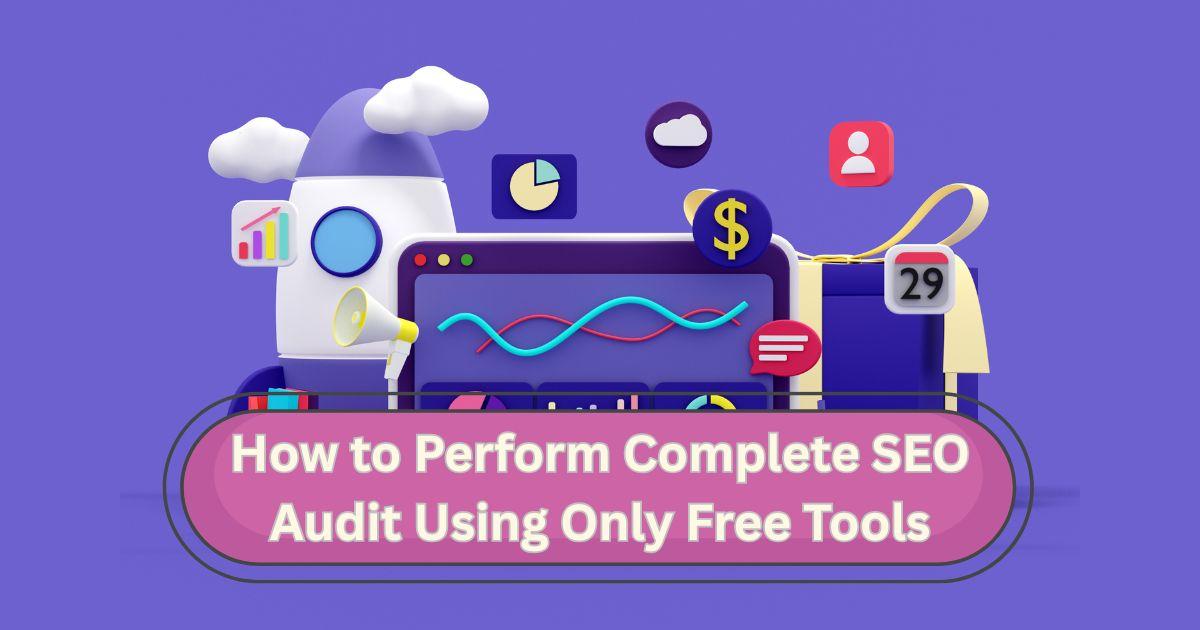Notifications

8 minutes, 7 seconds
-42 Views 0 Comments 0 Likes 0 Reviews

In today’s competitive online world, running a website without regular SEO audits is like driving a car without checking the engine. If you're a solopreneur or a small business owner, investing in expensive SEO services might not be feasible at first. The good news? You can still achieve professional-level results using free and paid SEO tools—especially the free ones.
This guide walks you through a complete, step-by-step SEO audit using only free SEO audit tools. Whether you're looking to uncover technical issues, improve on-page elements, or monitor performance, this guide will help you do it all—without spending a rupee.
The first step in any audit is to crawl your website and identify issues related to page indexing, broken links, or missing metadata. Tools like Screaming Frog SEO Spider (free version) and Ahrefs Webmaster Tools allow you to do this effectively.
They serve as powerful SEO testing tools that analyze everything from title tags and headers to redirects and response codes. These insights form the backbone of your SEO health.
Use this crawl data to find errors, duplicate content, or bloated pages that may be hurting your rankings. Pair it with Google SEO tools like Search Console for real-time performance data.
Now that you have technical data, it's time to check your content’s keyword effectiveness. Start with Google Keyword Tool (part of Google Ads). It gives you keyword ideas, search volume, and competition metrics.
Additionally, tools like Ubersuggest and Keyword Surfer are some of the best keyword research tools for discovering fresh, low-competition terms. Remember, keywords need to align with your audience's search intent—not just volume.
Mapping these terms will help with your on page SEO tools strategy, ensuring every important page is optimized for the right phrase.
With your keywords in place, review each page’s on-page optimization. Use SEO tracking tools like Yoast SEO (on WordPress) or Rank Math for real-time page analysis.
Check for:
Clear H1 and subheadings
Proper internal linking
Optimized images with alt text
Compelling meta descriptions
These tweaks may seem small but have a big impact. Leveraging these top SEO software features ensures your content is structured well for both users and search engines.
Fast-loading, mobile-optimized pages are now a ranking factor. Use Google PageSpeed Insights and GTmetrix, two of the most reliable SEO audit tools, to analyze performance metrics.
These AI powered SEO tools highlight issues like large images, unused CSS, or render-blocking scripts. Once fixed, re-test for improvement.
A mobile-friendly site also improves user experience, which supports your off page seo techniques by increasing time on site and reducing bounce rate.
Backlinks are essential for authority. Fortunately, you don’t need a paid tool to get started. Ahrefs Webmaster Tools and Ubersuggest offer limited but useful backlink data.
You can use these backlink analysis tools to check:
Number of referring domains
Domain authority of links
Anchor text distribution
These insights help you create better link-building strategies and even remove spammy links using disavow files in Search Console. Tools like OpenLinkProfiler also serve as a great backlink checker tool alternative.
Once changes are implemented, it’s essential to monitor how your site performs over time. Use Google Search Console and Bing Webmaster Tools to track keywords, impressions, CTRs, and rankings.
For deeper tracking, SERProbot is a popular rank tracking tool that lets you track multiple keywords for free. These top Free SEO tools allow you to monitor shifts in visibility and respond accordingly.
To stay ahead, you need to know what competitors are doing. Tools like SEOquake and SERPWatcher help perform SERP analysis tools assessments, allowing you to dissect competitor strategies.
Look at the titles they use, content length, structured data, and backlink profile. This helps you craft better content and adjust your Search Engine Optimization Services to match or beat theirs.
Understanding your competitor’s strengths will elevate your overall strategy—especially in saturated niches like Technology Articles or Job search websites.
Finally, use Google Data Studio (now Looker Studio) to create SEO dashboards. This connects with Google SEO tools like Analytics and Search Console to offer visual insights.
Use these reports to:
Track progress
Report KPIs
Justify future SEO investment
This becomes especially useful if you plan to outsource or hire SEO services later. Having a baseline report will help you assess ROI clearly.
Yes! While premium tools offer more data, free SEO audit tools like Google Search Console, Ahrefs Webmaster Tools, and Ubersuggest provide more than enough to conduct a comprehensive audit.
Ideally, run a full audit every 3–6 months, or after major site changes. Use SEO tracking tools to monitor ongoing performance in between.
Free and paid SEO tools both have their place. Start with free tools to learn the basics, and upgrade as your needs grow.
Ahrefs Webmaster Tools and OpenLinkProfiler are solid backlink checker tool options for those who need backlink data without cost.
Absolutely! Many AI powered SEO tools now analyze content quality, keyword density, and user intent more effectively, giving you a competitive edge.
Are you already using any of these top SEO software solutions? Or do you have a favorite among the best SEO tools that we missed? Let us know in the comments!

